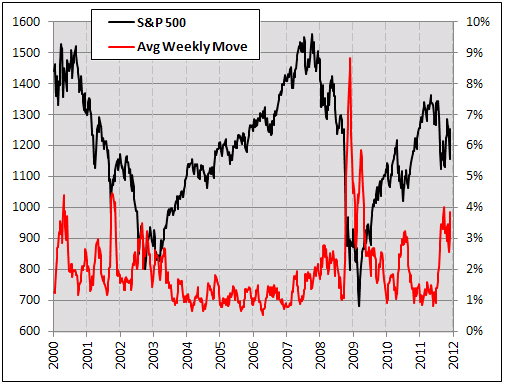After an apparently restful US holiday hiatus, the bulls were back in rare form last week. Last week marked the biggest weekly gain in the S&P 500 Index (SPX) since March 2009. Of course, the index was down big during the two weeks prior to this massive gain, and the SPX still hasn’t recouped what it lost over those two bearish weeks. In fact, most of the losses from the second half of November were wiped out in essentially two days of trading last week, and most of the action contained in those two days occurred at the opening bell. Despite a less-than-convincing finish on Friday, it’s starting to look like Wall Street may get its Santa Claus rally, after all. In any event, there’s no denying that volatility has returned. Below is a chart showing the two-month average weekly percentage move of the SPX, whether up or down. By this measure, volatility is higher now than at any other time since the 2008 market crash.
The positive catalyst this past week was a surprise coordinated action by central banks to help relieve the situation in Europe. Generally, well-received US retail sales and jobs data pushed the major market between 7% and 8% higher on the week. Will the market sustain any meaningful advances following the move to bolster dollar liquidity? From a contrarian view, we find any skepticism intriguing, as it’s a sign of sideline money and potential short-covering activity. Against this backdrop, the central banks’ actions could indeed drive a rally of substance.
One indicator that we continue to watch is the VIX. After a long period of trading above the 30 level, the VIX decreased substantially last week. When this ratio turned lower from extreme highs last year, a major market rally occurred. One difference between now and late 2010 is that the present direction of this ratio is being driven by a sharp decline in VIX put activity, whereas in late 2010, the decline in VIX put buying was accompanied by a sharp influx in VIX call buying. We see fund managers increasingly shorting stocks from June through October 2011, as the VIX put buying increased. The idea is that if equities shot higher, the VIX would suddenly plunge, and losses from short stock positions would be offset by profits from the VIX put options that were purchased as a hedge. The increase in shorting activity could have capped market rallies during the June-October period, but the present decrease in short-selling could signal weakening resistance as less supply, via shorting activity, enters the market. That said, bulls would like to see an increase in VIX call buying as a sign that fund managers are accumulating long positions, which would enhance the probability of a breakout above resistance.

